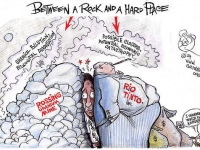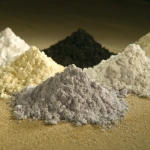Landmine of a Decision

In central Namibia, an enormous uranium mine sprawls across 5,600 acres of arid desert 40 miles inland from the Atlantic Ocean on Africa's southeastern coast. The mile-long, 2-mile-wide pit dwarfs even the goliath 25-foot-tall, 180-ton Komatsu haulers treading along roads hewn into the pit walls 1,000 feet below the rim. The operation is run by Rossing Uranium, whose parent company, Rio Tinto, is the world's largest mining conglomerate, with annual profits of $1.4 billion. It is one of the world's largest open-pit uranium mines, supplying unenriched yellowcake uranium destined for power-generating facilities in France, the United Kingdom, the United States, and Japan.
It is also steeped in a legacy of environmental, political, and human rights controversy that began when the mine opened in 1976. Initial investors included Iran as well as the apartheid regime in South Africa--both of whom reaped significant material and financial benefits from the mine's illegal exports during the U.N. sanctions against those nations. In the 1980s, the company was accused of employing an armed militia to enforce hostile working conditions. In the 1990s, the company faced a lawsuit from a former employee and cancer victim who claimed the company provided inadequate protections for its workers.
Now Rossing is making a decision that will affect not only its employees, but people in the surrounding region, as well as the Namibian economy and the environment. The company is deciding between spending $100 million for a 20-year expansion of the mine or ceasing operations entirely by the year 2007. According to officials at Rio Tinto, falling uranium prices and a weak U.S. dollar are altering the economic formula that has kept the enterprise profitable. Either way, much is at stake for Namibia.
Weighing the Issues
Peak production at this single facility accounts for roughly 3 percent of Namibia's GDP and 10 percent of the country's foreign exports, while offering employment to 800 Namibians in a region where jobs are as scarce as fresh water. However, Rossing's impressive annual contribution to the Namibian economy is accompanied by an equally impressive level of environmental destruction. Each year, the mine produces a waste stream of 20 million tons of crushed, sulfuric-acid-soaked, and slightly radioactive alaskite rock. In a region that collects fewer than 3 centimeters of annual rainfall, the plant consumes between 2 million and 3 million cubic meters of fresh water annually.
Given Rio Tinto's legacy of environmental and public relations disasters at mines such as Lihir and Freeport in Indonesia, Jabiluka in Australia, Capper Pass in the United Kingdom, Bouganville in Brazil, Kelian in Borneo, and most recently along the Madagascar coastline, Namibians aren't convinced their best interests will be part of Rossing's decision about the mine.
Erich Beukes, chairperson of the Rossing branch of Mineworkers Union of Namibia, calls the potential closure was a "very emotional issue." He worries that the outlook is bleak for the many unskilled, semiskilled, and mine-specific workers who would have very limited opportunities for alternative employment.
The mine's employees and concentric circles of goods and service providers sustained by the mine must now confront an uncertain future. "We cannot forget that our employees also employ people at their homes. Closing down the mine would take away their purchasing power. The impact is going to be major," Rehabeam Hoveka, manager for business services at Rossing told the Namibian (Namibia's national newspaper) when the closure plan was first announced.
Rossing officials emphasize that the closure is only one possible scenario but refuse to provide details before they make a final decision, which might not come until later this year. Nevertheless, the company has been begun a $3 million grants program to promote economic sustainability in the nearby mine-dependent company town of Arandis.
Rossing scientists also point to dramatic reductions in fresh water usage at the mine as evidence of Rossings' commitment environmental mitigation and protection. Significant investments in water recycling systems and improved ore-processing technologies have cut annual consumption at the mine from 10 million cubic meters in 1980 to just under 3 million last year. Eckart Demasius, municipal CEO of nearby Swakopmund, which oversees a large portion of Rossing's water supply, says Rossing's water conservation "sets the standard... for the responsible handling of water."
But it is unclear if life after Rossing would be as rosy. Rossing Managing Director David Salisbury acknowledged earlier this year that a trust fund established for environmental remediation projects had been plundered to compensate for recent operating losses.
No Clear or Clean Option
If mining is a dirty business, mine closures often prove to be even messier. Although Rossing has not revealed its remediation plan in the event of a closure, the industry-standard practice of covering decommissioned tailings ponds with a layer of gravel is proving to be a porous--and ineffectual-- barrier to airborne erosion of contaminated particles. The procedure also fails to prevent gaseous exhalation of highly carcinogenic Radon 2-2-2 and Radium 2-2-6 generated by the sludge. On the arid, windy Namib desert landscape, these hazards are troubling possibilities. The U.S. Environmental Protection Agency (EPA) estimates the lifetime excess lung cancer risk of people living near a tailings pile of 80 hectares at two cases per hundred. Rossings tailings ponds cover 730 hectares.
The alternative prospect of extended operations at Rossing is a perplexing mix of pros and cons. The central government appears unwilling to exercise meaningful regulatory control over the powerful minerals extraction sector, going so far as to openly indict international environmental standards as "..specifications that create problems for developing countries [like Namibia]."
New technical requirements are currently under consideration at Namibia's Ministry of Mines and Energy, but for now Namibia is one of only a few countries that does not require mining operations to submit industry-standard environmental impact assessments or environmental management program reports. Environmental stewardship has, in practice, been left in the hands of mining interests themselves. Perhaps not surprisingly, the federal government reports it is saddled with cleanup costs at more than 240 abandoned mines throughout the country.
It's debatable whether the lack of federal environmental regulations is the result of profit motives contaminating public affairs, a national pro-development economic policy, or classic political ineptitude. However, minerals extraction is plainly Namibia's biggest private-sector industry, depositing nearly half of the country's annual tax receipts and generating 40 percent of foreign exchange.
Future in a Balance
The question for the company right now, however, has more to do with economics than government regulations. The sagging uranium prices that prompted Rossing to consider decomissioning the mine are now making dramatic reversals, with the spot market leaping 61 percent to $17.60 a pound in the last nine months. Analysts speculate that global uranium production (92 million pounds in 2003) is now being outpaced by demand by a factor of nearly 2 to 1--a trend fueled by a growing global fleet of 450 commercial nuclear power plants coupled with an expected six-fold increase in Chinese nuclear power generating capacity over the next 20 years.
Although an official decision on the mine's future won't be announced until the fourth quarter of the year, remaining in Namibia to capitalize upon these trends may be just too attractive an opportunity for Rossing to pass up. In any case, the company's legacy will be with Namibia for a very long time to come.



